What Happens in dp4j LenetMnist Example
Class Diagram
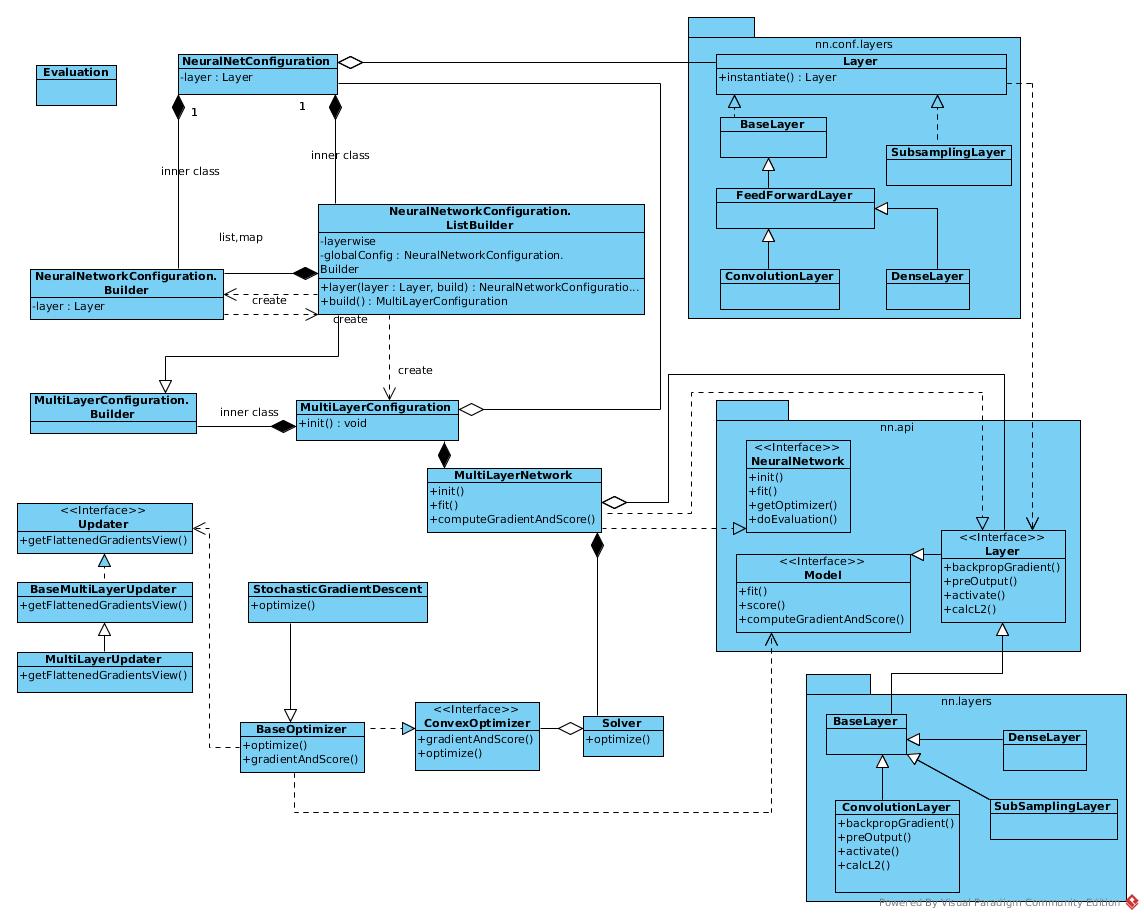
Sequence
CNN Structure
Codes Sequence
Initiation
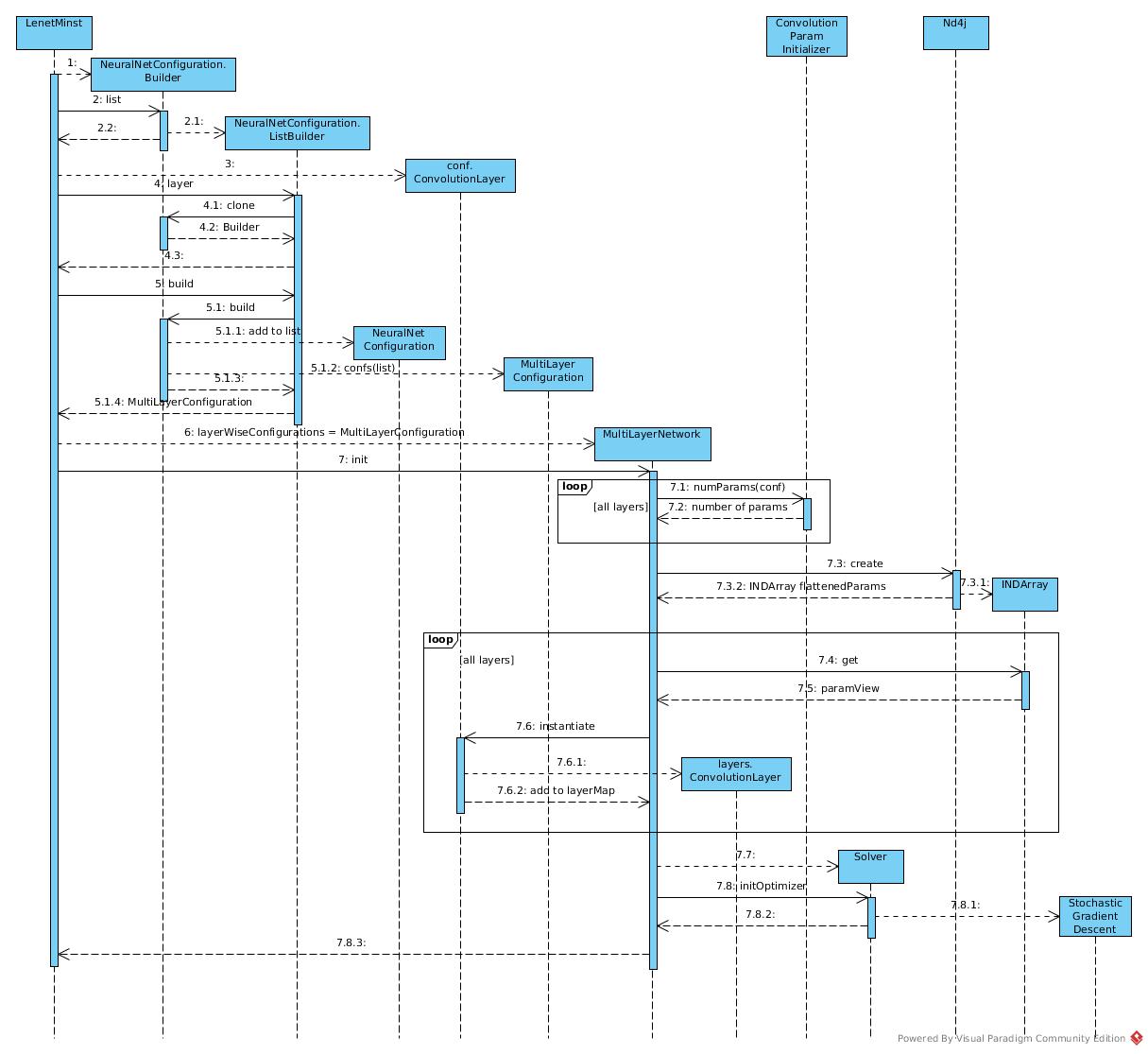
Fit
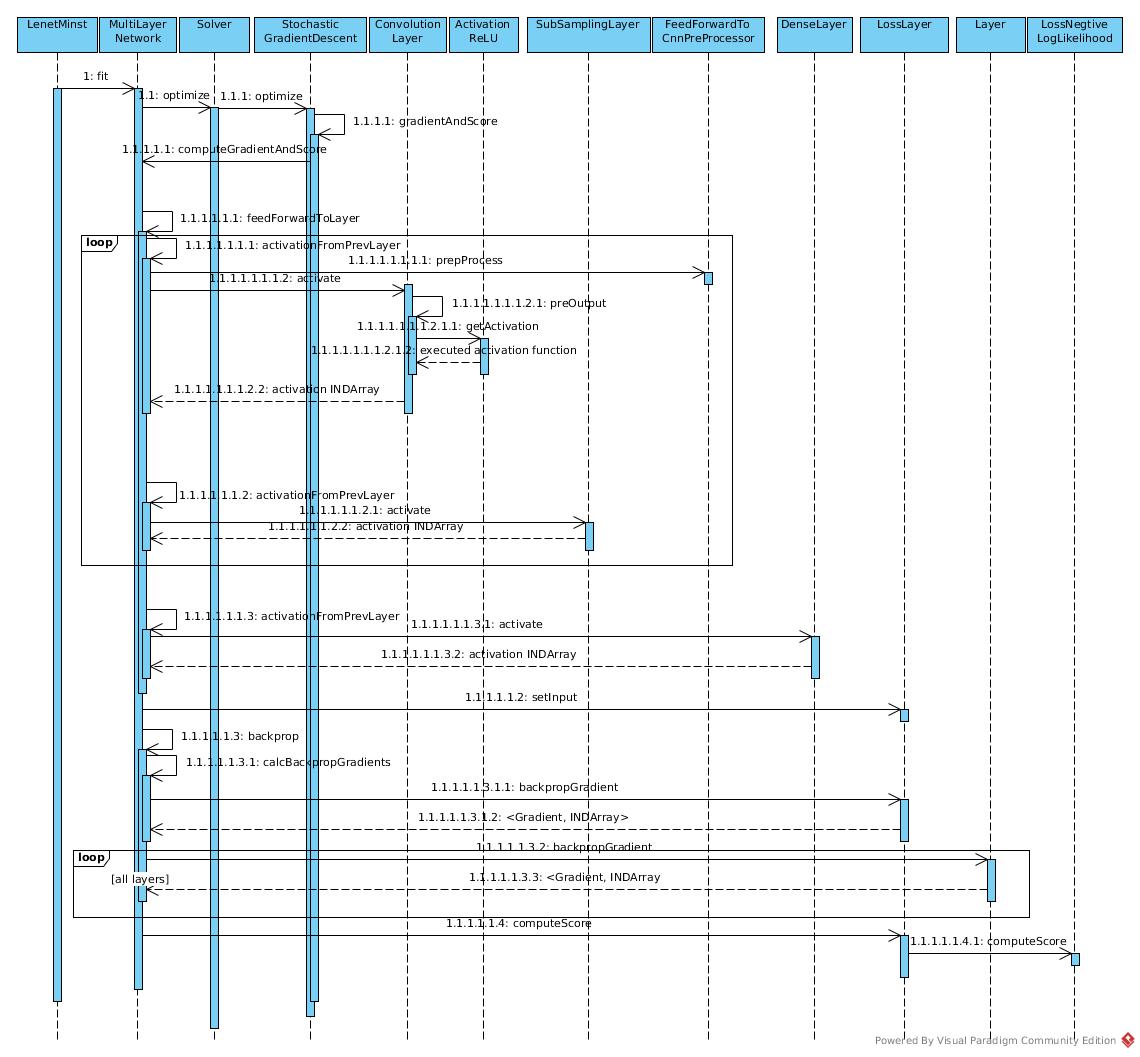
Computation
Initiation
Parameters
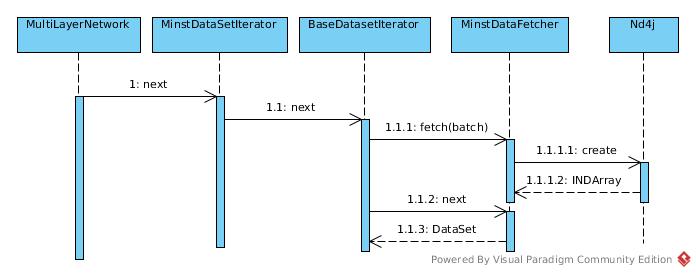 Count number of all parameters:
Count number of all parameters:
MultiLayerNetwork.init
for (int i = 0; i < nLayers; i++) {
NeuralNetConfiguration conf = layerWiseConfigurations.getConf(i);
nParamsPerLayer[i] = conf.getLayer().initializer().numParams(conf);
paramLength += nParamsPerLayer[i];
}
Take Convolution Layer for example:
ConvolutionParamInitializer.numParams
public int numParams(Layer l) {
org.deeplearning4j.nn.conf.layers.ConvolutionLayer layerConf =
(org.deeplearning4j.nn.conf.layers.ConvolutionLayer) l;
int[] kernel = layerConf.getKernelSize();
int nIn = layerConf.getNIn();
int nOut = layerConf.getNOut();
return nIn * nOut * kernel[0] * kernel[1] + (layerConf.hasBias() ? nOut : 0);
}
Create a huge bulk of memory in 1-dimension
MultiLayerNetwork.init
if (parameters != null) {
// ...
} else {
flattenedParams = Nd4j.create(1, paramLength);
initializeParams = true;
}
Assign part of this bulk into each layer in sequence
MultiLayerNetwork.init
int paramCountSoFar = 0;
for (int i = 0; i < nLayers; i++) {
INDArray paramsView;
if (nParamsPerLayer[i] > 0) {
//...
} else {
paramsView = null;
}
paramCountSoFar += nParamsPerLayer[i];
NeuralNetConfiguration conf = layerWiseConfigurations.getConf(i);
layers[i] = conf.getLayer().instantiate(conf, listeners, i, paramsView, initializeParams);
layerMap.put(conf.getLayer().getLayerName(), layers[i]);
}
Input/Label
For each mini batch, the input is organized into INDArray of batch * #imagebyte Similar to labels.
MnistDataFetcher.fetch
public void fetch(int numExamples) {
//...
float[][] featureData = new float[numExamples][0];
float[][] labelData = new float[numExamples][0];
int actualExamples = 0;
byte[] working = null;
for (int i = 0; i < numExamples; i++, cursor++) {
if (!hasMore())
break;
byte[] img = man.readImageUnsafe(order[cursor]);
//...
int label = man.readLabel(order[cursor]);
//...
float[] featureVec = new float[img.length];
featureData[actualExamples] = featureVec;
labelData[actualExamples] = new float[numOutcomes];
labelData[actualExamples][label] = 1.0f;
//...
actualExamples++;
}
//...
INDArray features = Nd4j.create(featureData);
INDArray labels = Nd4j.create(labelData);
curr = new DataSet(features, labels);
}
Set the shape data.length * data[0].length
public BaseNDArray(float[][] data, char ordering) {
this(Nd4j.createBuffer(ordering == 'c' ? ArrayUtil.flatten(data) : ArrayUtil.flattenF(data)),
new int[] {data.length, data[0].length},
Nd4j.getStrides(new int[] {data.length, data[0].length}, ordering), 0, ordering);
}
Forward Propagation
Input
Input of each layer is set at
AbstractLayer.java
@Override
public INDArray activate(INDArray input, boolean training) {
setInput(input);
return activate(training);
}
Input type was set in MultiLayerConfiguration builder
LenetMins.java
.setInputType(InputType.convolutionalFlat(inputImageSize, inputImageSize, channelNum))
A PreProcessor was created:
MultiLayerConfiguration.Builder.build
if (inputType != null) {
InputType currentInputType = inputType;
for (int i = 0; i < confs.size(); i++) {
Layer l = confs.get(i).getLayer();
if (inputPreProcessors.get(i) == null) {
//Don't override preprocessor setting, but set preprocessor if required...
InputPreProcessor inputPreProcessor = l.getPreProcessorForInputType(currentInputType);
if (inputPreProcessor != null) {
inputPreProcessors.put(i, inputPreProcessor);
}
}
//...
}
//...
}
For CNN layer, a default FeedForwardToCnnPreProcessor is created
@JsonCreator
public FeedForwardToCnnPreProcessor(@JsonProperty("inputHeight") int inputHeight,
@JsonProperty("inputWidth") int inputWidth, @JsonProperty("numChannels") int numChannels) {
this.inputHeight = inputHeight;
this.inputWidth = inputWidth;
this.numChannels = numChannels;
}
Preprocessor is executed before active() for each layer. MultiLayerNetwork aggregate them. It is not embedded in ConvolutionLayer class
public INDArray activationFromPrevLayer(int curr, INDArray input, boolean training) {
// ...
input = getLayerWiseConfigurations().getInputPreProcess(curr).preProcess(input, getInputMiniBatchSize());
// ...
INDArray ret = layers[curr].activate(input, training);
return ret;
}
The 2-dim buffer is reshaped into 4-dim buffer
FeedForwardToCnnPreProcessor.java
@Override
public INDArray preProcess(INDArray input, int miniBatchSize) {
//...
return input.reshape('c', input.size(0), numChannels, inputHeight, inputWidth);
}
Convolution Layer
Suppose batchSize = 2. The layer should be like the following figure Take the numbers in the figure for example.
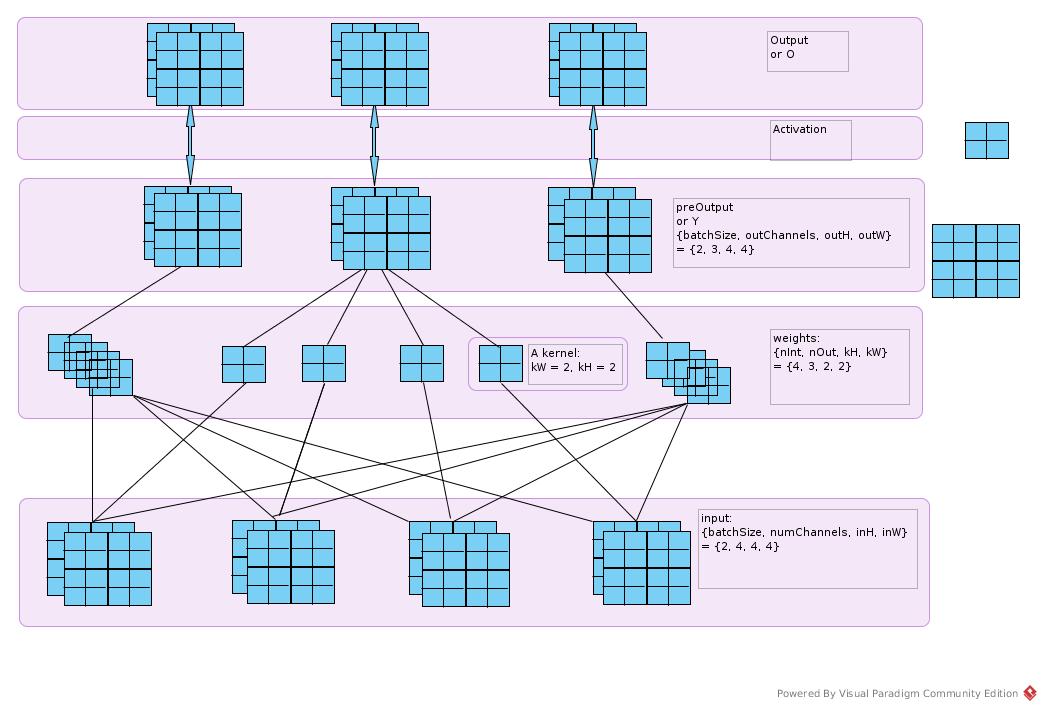
ConvolutionLayer.preOutput
INDArray bias = getParamWithNoise(ConvolutionParamInitializer.BIAS_KEY, training);
INDArray weights = getParamWithNoise(ConvolutionParamInitializer.WEIGHT_KEY, training);
weights is of dim {nIn, nOut, kernelHeight, kernelWidth}. input is of dim {batchSize, numChannels, inputHeight, inputWidth} “n” and “depth of channel” and “number of channels” are the same
INDArray col = Nd4j.createUninitialized(new int[] {miniBatch, outH, outW, inDepth, kH, kW}, 'c');
INDArray col2 = col.permute(0, 3, 4, 5, 1, 2);
Create INDArray of size (miniBatch * outH * outW * inDepth * kH * kW) Permute into shape (miniBatch, inDepth, kH, kW, outH, outW)
Convolution.im2col(input, kH, kW, strides[0], strides[1], pad[0], pad[1], dilation[0], dilation[1],
convolutionMode == ConvolutionMode.Same, col2);
INDArray im2col2d = Shape.newShapeNoCopy(col, new int[] {miniBatch * outH * outW, inDepth * kH * kW}, false);
im2col expand the input into 2-dim matrix. That is, to extract each block that would be conved with a set of kernel to a line of matrix
INDArray permutedW = weights.permute(3, 2, 1, 0);
INDArray reshapedW = permutedW.reshape('f', kW * kH * inDepth, outDepth);
And to extract each set of kernel as a column of a matrix
z = im2col2d.mmul(reshapedW);
Just like the following figure
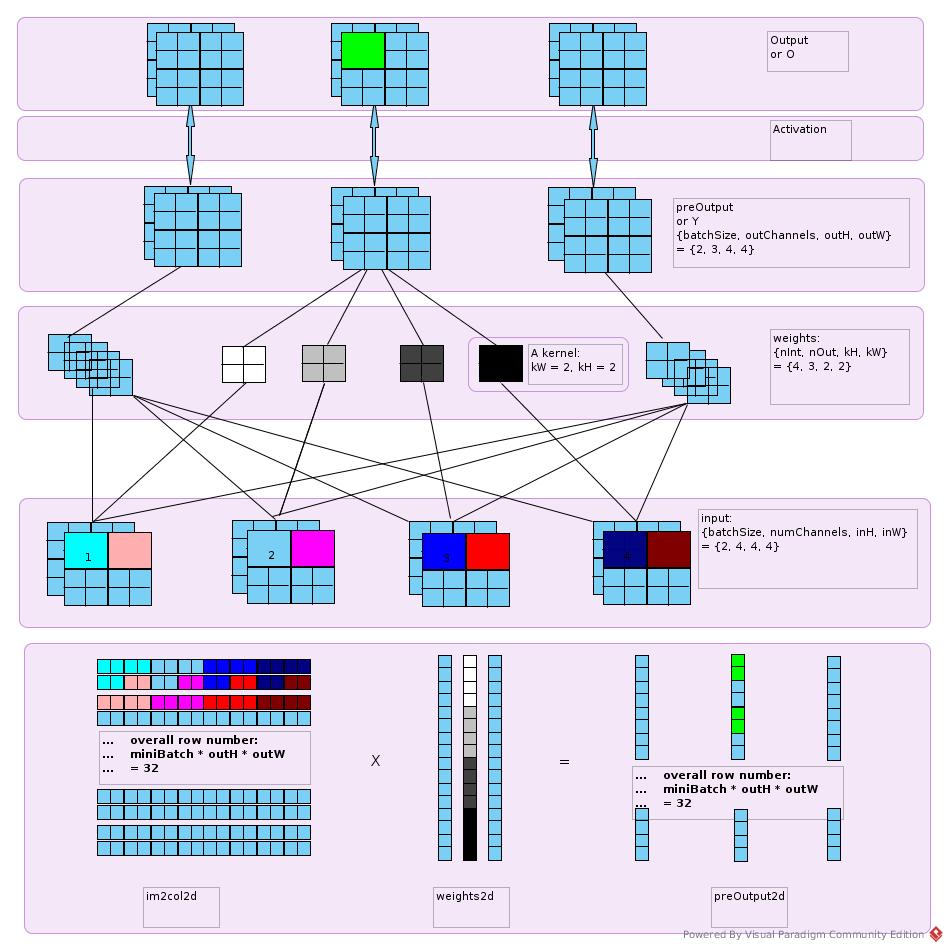
Multiply them and get the z, that is, output before activation
z = Shape.newShapeNoCopy(z, new int[] {outW, outH, miniBatch, outDepth}, true);
z = z.permute(2, 3, 1, 0);
Reshape z in shape {miniBatch, outDepth, outH, outW} It is permute(2, 3, 1, 0) in stead of (2, 3, 0, 1) is that the next block counted by row number in input while in col number in output matrix.
ConvolutionLayer.activate()
INDArray activation = afn.getActivation(z, training);
ActivationReLU.getActivation()
@Override
public INDArray getActivation(INDArray in, boolean training) {
Nd4j.getExecutioner().execAndReturn(new RectifedLinear(in));
return in;
}
Output is of the same dim as z, which is 4 rank matrix. And is sent to subsampling layer.
Subsample Layer
Not confirmed. Guess that the max pooling is executed by:
SubsamplingLayer.activate
--> Convolution.pooling2D
--> Nd4jCpu.double_maxpool2d
--> libnd4j maxpool2d.cpp
--> OpenBlas
And also guess that OpenBlas does not have too much trick. It is a SIMD of naive implementation as Caffe does. Caffe CNN Layer
Dense Layer
BaseLayer.preOutput()
INDArray ret = input.mmul(W);
BaseLayer.activate()
INDArray ret = layerConf().getActivationFn().getActivation(z, training);
Output Layer
set input of output layer
MultiLayerNetwork.computeGradientAndScore()
INDArray actSecondLastLayer = activations.get(activations.size() - 1);
getOutputLayer().setInput(actSecondLastLayer);
backprop();
set labels of output layer
MultiLayerNetwork.calcBackpropGradients()
outputLayer.setLabels(labels);
currPair = outputLayer.backpropGradient(null);
Get the output
LossMCXENT.computeGradient()
INDArray output = activationFn.getActivation(preOutput.dup(), true);
Then computed by ActivationSoftmax.getActivation()
Annotation in ActivationSoftmax.java
/**
* f_i(x) = exp(x_i - shift) / sum_j exp(x_j - shift)
* where shift = max_i(x_i)
*/
Suppose it is a kind of normalization. To be clarified.
Back Propagation
Output Layer
The loss function is created without weights parameters
OutputLayer.Builder
public Builder(LossFunction lossFunction) {
super.lossFunction(lossFunction);
}
The gradient was computed as:
LossMCXENT.computeGradient()
grad = output.subi(labels); //labels is one-hot vector
softmax gradient English softmax gradient Chinese The output layer is as the following figure:
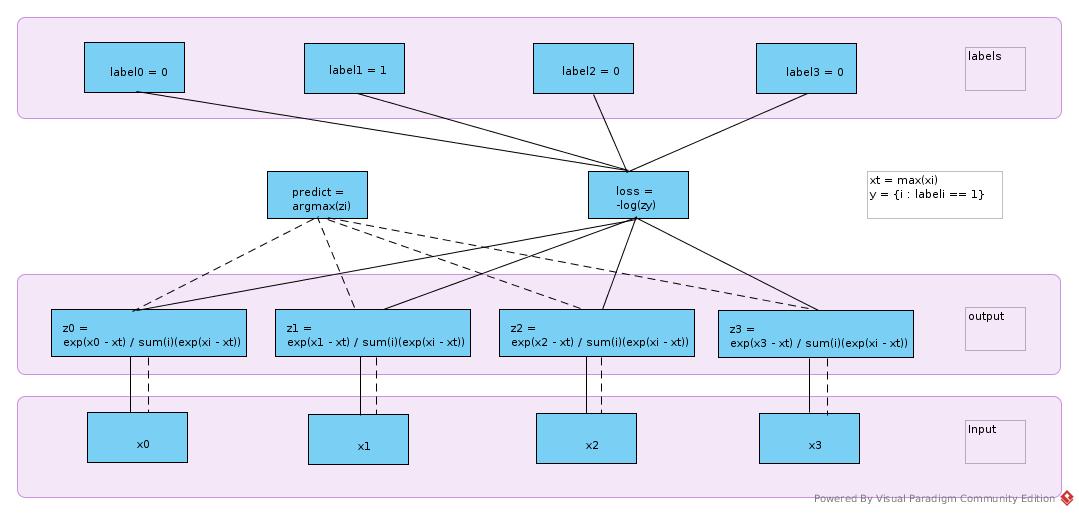
Σ(k) means sum over index k
sigma(i, j) = (i == j)
loss = l = -log(zy), labels(y) = 1
zi = exp(xi - xt) / Σ(k)(exp(xk - xt)), xt = max(xk)
dzi/dxj = (sigma(i, j) * exp(xi - xt) / Σ) + (exp(xi - xt) * (-1) * (Σ ^ (-2)) * exp(xj - xt))
= (exp(xi - xt) / Σ) * (sigma(i, j) - exp(xj - xt) / Σ)
= zi * (sigma(i, j) - zj)
dl/dzi = sigma(y, i) * (-1) * (1 / zi)
dl/dxj = Σ(i)((dl/dzi) * (dzi/dzj))
= Σ(i)(sigma(y, i) * (1 / zi) * zi * (zj - sigma(i, j)))
= Σ(i)(sigma(y, i) * (zj - sigma(i, j)))
As sigma(y, i) == 0 when (y != i)
--> dl/dxj = zj - sigma(y, j)
And sigma(y, j) == labels
--> dL/dX = output - labels
Dense Layer
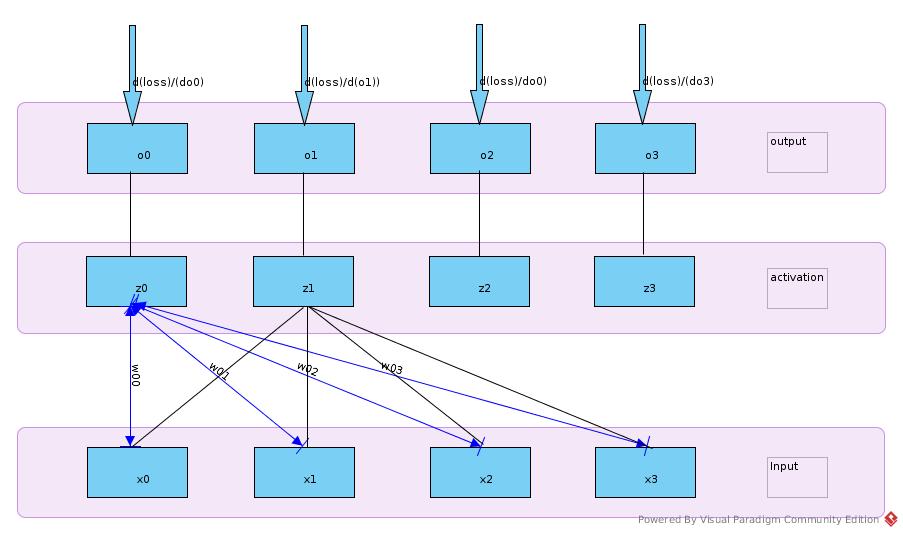
f = do / dz
epsilon = dl / do
dl/dwij = (dl/doi) * (doi/dzi) * (dzi / dwij)
= epsilon(i) * f(i) * xj
dl/dxi = Σ(k)((dl/dok) * (dok/dzk) * (dzk/dxi))
= Σ(k)(epsilon(k) * f(k) * w(k,i)
The back propagation happens in
DenseLayer --> BaseLayer.backpropGradient()
@Override
public Pair<Gradient, INDArray> backpropGradient(INDArray epsilon) {
//get z
INDArray z = preOutput(true);
//get f based on value of z
//and get (f muli epsilon)
INDArray delta = layerConf().getActivationFn().backprop(z, epsilon).getFirst(); //TODO handle activation function params
Gradient ret = new DefaultGradient();
INDArray weightGrad = gradientViews.get(DefaultParamInitializer.WEIGHT_KEY); //f order
//weightGrad = input * delta = input * (f muli epsilon)
Nd4j.gemm(input, delta, weightGrad, true, false, 1.0, 0.0);
ret.gradientForVariable().put(DefaultParamInitializer.WEIGHT_KEY, weightGrad);
//End of w gradient
if(hasBias()){
INDArray biasGrad = gradientViews.get(DefaultParamInitializer.BIAS_KEY);
delta.sum(biasGrad, 0); //biasGrad is initialized/zeroed first
ret.gradientForVariable().put(DefaultParamInitializer.BIAS_KEY, biasGrad);
}
//get w
INDArray W = getParamWithNoise(DefaultParamInitializer.WEIGHT_KEY, true);
//get W * (f muli epsilon)
INDArray epsilonNext = W.mmul(delta.transpose()).transpose();
//End of x gradient
weightNoiseParams.clear();
return new Pair<>(ret, epsilonNext);
}
Subsampling Layer
SubsamplingLayer.backpropGradient()
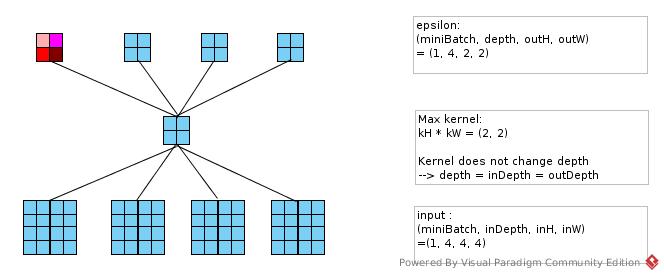
col6d = Nd4j.create(new int[] {miniBatch, inDepth, outH, outW, kernel[0], kernel[1]}, 'c');

epsilon1d = epsilon.reshape('c', ArrayUtil.prod(epsilon.length()), 1); //zero copy reshape

Convolution.im2col(input, kernel[0], kernel[1], strides[0], strides[1], pad[0], pad[1], dilation[0], dilation[1],
convolutionMode == ConvolutionMode.Same, col6dPermuted);

INDArray isMax = Nd4j.getExecutioner().execAndReturn(new IsMax(col2d, 1));

isMax.muliColumnVector(epsilon1d);

Convolution.col2im(col6dPermuted, outEpsilon, strides[0], strides[1], pad[0], pad[1], inputHeight, inputWidth, dilation[0], dilation[1]);

Get the output

Convolution Layer
There are many respectable documents about convolution back propagation. So, just put the im2col/col2im view as implemented in dp4j In forward phase, we have
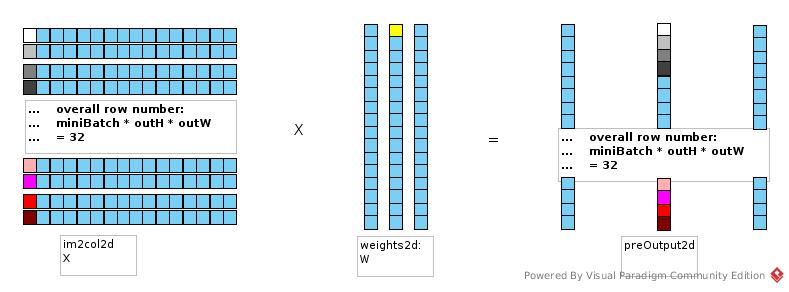
The certain weight contributes to output by corresponding input.
preOutput(i, j) = Σ(k)(X(i, k) * W(k, j))
d(preOutput(i, j))/d(W(k, j)) = X(i, k)
d(loss)/d(w(k, j)) = Σ(i)((d(preOutput(i, j)/d(W(k, j))) * (d(l)/d(preOutput(i, j))))
= Σ(i)(X(i, k) * epsilon(i, j) * df(i, j))
= Σ(i)((X.transpose()(k, i)) * epsilon(i, j) * df(i, j))
= X.row(k) * (epsilon dot f).col(j)
ConvolutionLayer.backpropGradient()
// p.first is of preOutputShape
// afn.backprop get df/dpreOutput and executed element wise product of epsilon
delta = afn.backprop(p.getFirst(), epsilon).getFirst(); //TODO handle activation function params
delta = delta.permute(1, 0, 2, 3); //To shape: [outDepth,miniBatch,outH,outW]
INDArray delta2d = delta.reshape('c', new int[] {outDepth, miniBatch * outH * outW}); //Shape.newShapeNoCopy(delta,new int[]{outDepth,miniBatch*outH*outW},false);
//im2col2d is as described in previous figure
INDArray im2col2d = p.getSecond(); //Re-use im2col2d array from forward pass if available; recalculate if not
//get im2col2d and delta2d both transposed
Nd4j.gemm(im2col2d, delta2d, weightGradView2df, true, true, 1.0, 0.0);
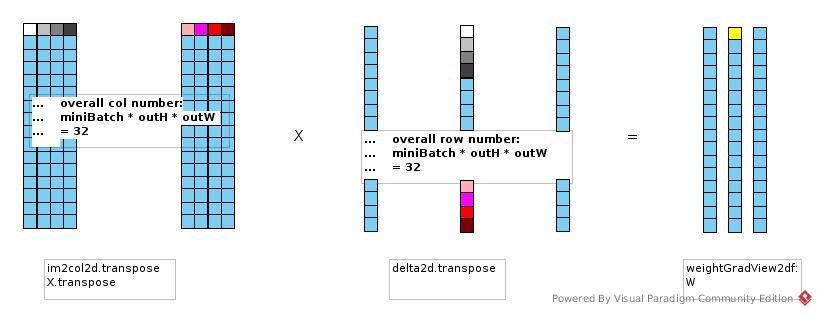
Similarly
preOutput(i, j) = Σ(k)(X(i, k) * W(k, j))
d(preOutput(i, j))/d(X(i, k)) = W(k, j)
d(l)/d(X(i, k)) = Σ(j)(W(k, j) * epsilon(i, j) * df(i, j))
As preOutput2d is of shape (batch * outH * outW, outDepth)
And delta2d is of shape (outDepth, batch * outH * outW)
-->
d(l)/d(X(i, k)) = Σ(j)(W(k, j) * delta2d(j, i))
= W.row(k) * delta2d.col(i)
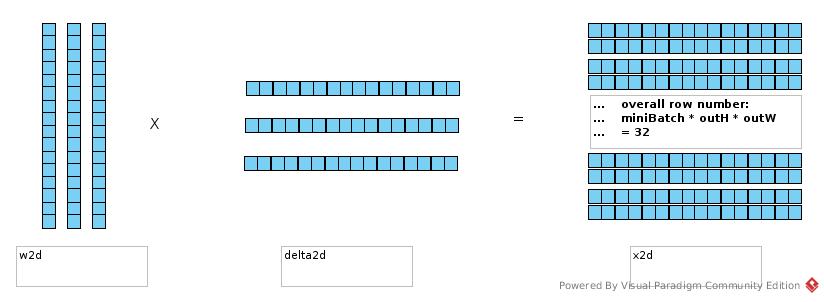
Update
StochasticGradientDescent.optimize()
//Update all parameters by configured updater
stepFunction.step(params, gradient.gradient());
//Set the updated parameters
model.setParams(params);
Score
The score sequence is like:
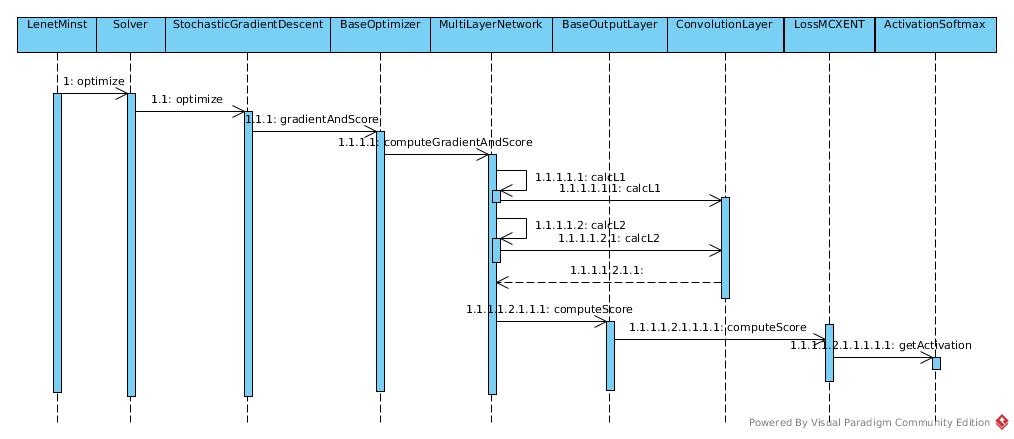
It computes L1 and L2 normalization at first. There is no such regularization in this example. And then to compute the score in LossMCXENT.scoreArray
INDArray output = activationFn.getActivation(preOutput.dup(), true);
INDArray scoreArr = Transforms.log(output, false).muli(labels);
Just to execute the softmax function and get the log of them. Then pick the one whose label == 1.it